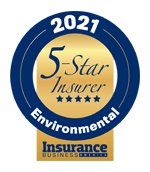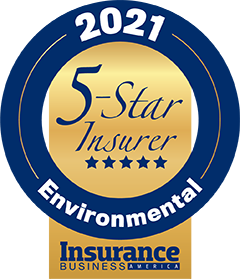
America's Best Environmental Impairment Liability
Five-Star Awards : Environmental Insurance
Environmental impairment liability
Environmental impairment liability insurance (EIL), which is essentially the same as pollution legal liability (PLL) and site/premises coverage, covers liabilities related to environmental harm or pollution. For example, it insures against accidental pollution from normal business operations, pollution from business products and other events that might result in environmental damages.
The demand for EIL continues to grow due to multiple factors, according to RT Specialty’s Jeff Slivka, and the market has seen an uptick in pollution claims over the past several years.
“Coverage terms have been impacted in recent years by the types of risk and a combination of high-profile mold exposures, rising Legionella claims, natural disasters, site development claims and the growing focus on emerging contaminants such as per- and polyfluoroalkyl substances [PFAS], as well as communicable disease (CD) or COVID-related claims,” Slivka says. “Specifically speaking to CD or COVID, there are a few carriers who continue to offer disinfection expense, providing some level of coverage to those eligible risks who are subject to the cost to cleanup after exposure to COVID, such as healthcare and other medical facilities.”
5-Star Excellence Awards
- Allianz Insurance
- AXA XL
- AXIS Capital
- Beacon Hill
- Beazley
- Berkley Environmental
- Crum & Forster
- Freberg Environmental
- The Hartford
- Ironshore
- Virtue Risk
- Westchester
- Zurich
What is Environmental Impairment Liability insurance?
Environmental Impairment Liability (EIL) is an insurance policy that covers environmental damage from pollution and toxic spills. Unlike general liability insurance – which can cover accidents and injuries that cause damage to employees, property, and equipment – environmental liability insurance is more specifically for businesses that handle or store toxic materials.
EIL covers accidental pollution that arises from standard operations, pollution produced by the businesses products, and any other mishap resulting in environmental damage. For instance, if a gold mine spills toxins into a body of water, contaminating waterfront properties, it may cause millions of dollars in damage. EIL insurance, however, would protect from liability resulting from that type of incident. Companies at a lower risk of polluting, like organic farming companies, may not require this type of coverage.
General environmental liability insurance can cover clean-ups that are stipulated by state governments, including property damage, bodily injury, and third-party claims. Environmental liability policies also cover legal expenses resulting from incidents of contamination or pollution.
What are considered environmental liabilities?
When a buyer is purchasing an asset or business that is likely to negatively effect the environment, environmental liability is crucial. For instance, when you buy a piece of equipment that is likely to cause water or air pollution, an environmental assessment is done to understand the different kinds of environmental liability related to the equipment being bought.
The different types of environmental liabilities depend on their source, and is typically connected to local, state, or federal laws. The most common types include:
Compliance obligations. These are regulations overseeing the building, disposal, and use of harmful substances, like, for instance, chemicals, on the environment. When buying a piece of equipment or asset for their business, you have to respect current compliance regulations.
Remediation obligations. Remediation obligations force businesses to limit the impacts of industrial activities and pollution on the environment as well as human health. Managing present obligations can limit the remediation obligations you may need to meet at a future date.
Fines and penalties. For non-compliance, a company might also be forced to pay penalties or fines, with applicable regulations and laws protecting the environment from degradation or pollution. The price is in addition to the price of compliance that a company must pay.
Compensation obligations. This is what a company may have to pay for environmental damages caused by pollution to property or to individuals. It is possible that you could face compensation obligations following compliance with every other environmental obligation.
Punitive damages. Punitive damages are like compensation obligations – but are more expensive. Generally this is used as a deterrent for firms that have little regard for stakeholders and for other companies that engage in similar conduct.
Common misconceptions about environmental liabilities
A common misconception surrounding environmental liabilities is that many insureds believe they are covered for pollution damages by property policies or general liability. Those policies, however, either limit or do not include that type of coverage, making you vulnerable to extremely pricey risks. Misinterpretation of language in policies typically results in litigation over environmental risks and coverage. It is not environmental coverage, specialists argue, if there is no insuring agreement that is explicit about pollutants causing losses. A lot of the times, policyholders are unaware of exposures to environmental losses and were uninformed about options for environmental insurance coverage.
Does general liability insurance cover environmental liability?
General liability insurance policies typically do not include losses resulting from pollution, which makes environmental policies a requirement for especially those businesses that handle or store toxic materials. The kinds of pollution that general liability policies cover is usually caused by smoke damage from an intense fire, or the fumes emitted by faulty cooling or heating systems. One of the most significant pollution issues a lot of companies are forced to watch for is asbestos. Usually, this involves handling the disposal of materials from a previously unoccupied site, or safely installing materials which may contain asbestos. Asbestos abatement liability insurance covers bodily injury or property damage caused by abatement operations. If asbestos is released in some way, business owners are insured by asbestos containment coverage.
Sudden & Accidental Liability vs. Environmental Impairment Liability: Know the difference
A property owner can buy sudden and accidental (S&A) pollution liability under a commercial general liability (CGL) policy. Typically, CGL policies exclude covering damages resulting from pollution. A thorough insurance broker will, however, seek a negotiation that will include an S&A extension. This will provide third-party liability coverage for property damage and bodily injury caused by a polluting incident.
Compared to environmental impairment liability, coverage under the S&A extension is relatively limited. This type of policy will provide third party coverage and is limited to a time period of discovery and reporting following the incident, which is why it is called “sudden and accidental”. The S&A extension usually does not include the owner’s own site remediation, government clean-up orders, or waste management activities. Because CGL policies typically don’t use this extension in the wording, coverage is usually overlooked.
Environmental Impairment Liability, by comparison, covers first and third parties for unforeseen pre-existing conditions and new pollution incidents, whether they happen in a sudden manner or gradually. While pre-existing conditions that are previously known are typically not included, coverage can resume following a site’s remediation and is deemed clean.
Keep up with the latest news and events
Join our mailing list, it’s free!


